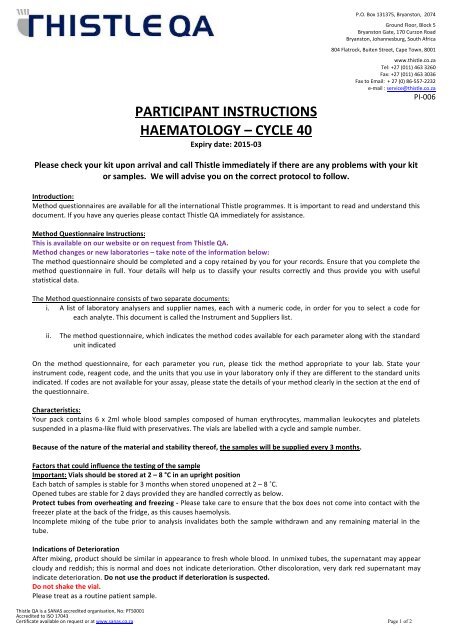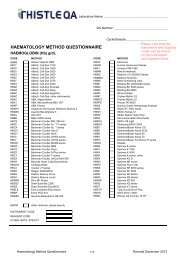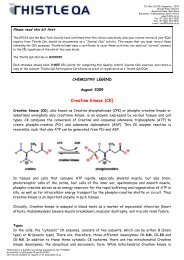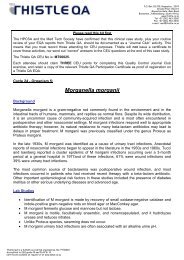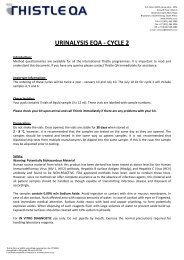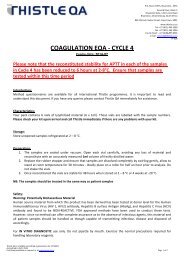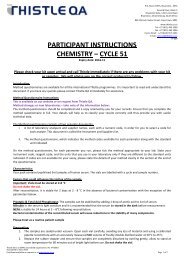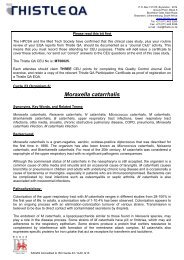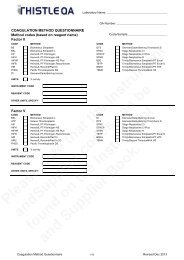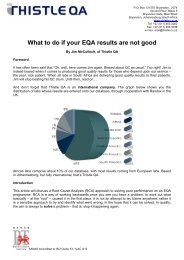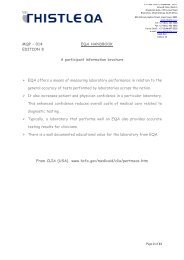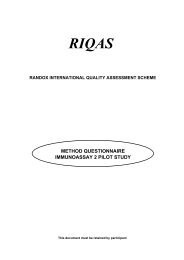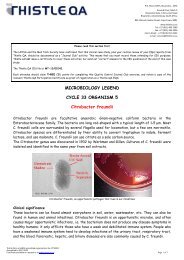PARTICIPANT INSTRUCTIONS HAEMATOLOGY ... - Thistle QA
PARTICIPANT INSTRUCTIONS HAEMATOLOGY ... - Thistle QA
PARTICIPANT INSTRUCTIONS HAEMATOLOGY ... - Thistle QA
Create successful ePaper yourself
Turn your PDF publications into a flip-book with our unique Google optimized e-Paper software.
P.O. Box 131375, Bryanston, 2074<br />
Ground Floor, Block 5<br />
Bryanston Gate, 170 Curzon Road<br />
Bryanston, Johannesburg, South Africa<br />
804 Flatrock, Buiten Street, Cape Town, 8001<br />
<strong>PARTICIPANT</strong> <strong>INSTRUCTIONS</strong> <br />
<strong>HAEMATOLOGY</strong> – CYCLE 40 <br />
Expiry date: 2015-‐03 <br />
www.thistle.co.za<br />
Tel: +27 (011) 463 3260<br />
Fax: +27 (011) 463 3036<br />
Fax to Email: + 27 (0) 86-‐557-‐2232<br />
e-‐mail : service@thistle.co.za<br />
PI-‐006<br />
Please check your kit upon arrival and call <strong>Thistle</strong> immediately if there are any problems with your kit <br />
or samples. We will advise you on the correct protocol to follow. <br />
Introduction: <br />
Method questionnaires are available for all the international <strong>Thistle</strong> programmes. It is important to read and understand this<br />
document. If you have any queries please contact <strong>Thistle</strong> <strong>QA</strong> immediately for assistance.<br />
Method Questionnaire Instructions: <br />
This is available on our website or on request from <strong>Thistle</strong> <strong>QA</strong>. <br />
Method changes or new laboratories – take note of the information below: <br />
The method questionnaire should be completed and a copy retained by you for your records. Ensure that you complete the<br />
method questionnaire in full. Your details will help us to classify your results correctly and thus provide you with useful<br />
statistical data.<br />
The Method questionnaire consists of two separate documents:<br />
i. A list of laboratory analysers and supplier names, each with a numeric code, in order for you to select a code for<br />
each analyte. This document is called the Instrument and Suppliers list.<br />
ii.<br />
The method questionnaire, which indicates the method codes available for each parameter along with the standard<br />
unit indicated<br />
On the method questionnaire, for each parameter you run, please tick the method appropriate to your lab. State your<br />
instrument code, reagent code, and the units that you use in your laboratory only if they are different to the standard units<br />
indicated. If codes are not available for your assay, please state the details of your method clearly in the section at the end of<br />
the questionnaire.<br />
Characteristics: <br />
Your pack contains 6 x 2ml whole blood samples composed of human erythrocytes, mammalian leukocytes and platelets<br />
suspended in a plasma-‐like fluid with preservatives. The vials are labelled with a cycle and sample number.<br />
Because of the nature of the material and stability thereof, the samples will be supplied every 3 months. <br />
Factors that could influence the testing of the sample <br />
Important: Vials should be stored at 2 – 8 °C in an upright position <br />
Each batch of samples is stable for 3 months when stored unopened at 2 – 8 ˚C.<br />
Opened tubes are stable for 2 days provided they are handled correctly as below.<br />
Protect tubes from overheating and freezing -‐ Please take care to ensure that the box does not come into contact with the<br />
freezer plate at the back of the fridge, as this causes haemolysis.<br />
Incomplete mixing of the tube prior to analysis invalidates both the sample withdrawn and any remaining material in the<br />
tube.<br />
Indications of Deterioration<br />
After mixing, product should be similar in appearance to fresh whole blood. In unmixed tubes, the supernatant may appear<br />
cloudy and reddish; this is normal and does not indicate deterioration. Other discoloration, very dark red supernatant may<br />
indicate deterioration. Do not use the product if deterioration is suspected. <br />
Do not shake the vial. <br />
Please treat as a routine patient sample.<br />
<strong>Thistle</strong> <strong>QA</strong> is a SANAS accredited organisation, No: PTS0001<br />
Accredited to ISO 17043<br />
Certificate available on request or at www.sanas.co.za Page 1 of 2
P.O. Box 131375, Bryanston, 2074<br />
Ground Floor, Block 5<br />
Bryanston Gate, 170 Curzon Road<br />
Bryanston, Johannesburg, South Africa<br />
804 Flatrock, Buiten Street, Cape Town, 8001<br />
www.thistle.co.za<br />
Tel: +27 (011) 463 3260<br />
Fax: +27 (011) 463 3036<br />
Fax to Email: + 27 (0) 86-‐557-‐2232<br />
e-‐mail : service@thistle.co.za<br />
PI-‐006<br />
Preparation: <br />
1. Allow the vial to warm at room temperature for 15 minutes before mixing.<br />
2. Mix the sample by holding the tube horizontally between the palms of the hands. Do not pre-‐mix on a mechanical <br />
mixer. <br />
3. Roll the vial between your palms for 20 -‐ 30 seconds, occasionally inverting the tube. Mix vigorously, but DO NOT <br />
SHAKE. <br />
4. Continue to mix in this manner until the red cells are completely suspended. Tubes stored for a long time may<br />
require extra mixing.<br />
5. Gently invert the tube 8 -‐ 10 times immediately before analysing the sample.<br />
6. After sampling<br />
a) Automatic sample handling: remove the tube from the sample handler immediately after sampling.<br />
b) Manual sample handling: Carefully wipe the rim of the tube and cap with a lint free tissue and replace the cap.<br />
7. Return the tube to the refrigerator within 30 minutes after use.<br />
Safety: <br />
Warning: Potentially Biohazardous Material <br />
Each donor has been tested and found to be negative for HbsAg, Anti-‐HCV, HCV (RNA), HIV-‐1 and HIV-‐1/2. Each donor is also<br />
found to be negative for Syphilis (RPR or STS). For complete protection exercise the normal precautions required for handling<br />
laboratory specimens. Dispose of used samples as you would patient samples.<br />
Return of Results: <br />
Each of the samples has a number printed on the label. We recommend analysis dates as shown below. Please send your<br />
results at the latest on the final cut-‐off dates given below. If the recommended analysis date does not allow you to get<br />
results to us on time, please analyse earlier. Use the correct dates for the sample numbers in the kit sent to your laboratory.<br />
If in doubt, please contact <strong>Thistle</strong> immediately for assistance. No results will be accepted after the final cut-‐off date.<br />
Additional Notes: <br />
Web site submission is available – please enter via web site using the user name and password given to you by <strong>Thistle</strong> <strong>QA</strong>.<br />
EDI system users must work through their relevant <strong>QA</strong> Divisions to ensure that results are imported in due time.<br />
The reports will be posted / e-‐mailed within 7-‐10 working days after the FINAL cut-‐off date.<br />
Collusion and/or falsification of E<strong>QA</strong> results are not good accreditation practice.<br />
Return Dates for Results <br />
Haematology <br />
Sample No: Analysis Dates: Final Cut-‐off Dates:<br />
7 08 December 2014 15 December 2014<br />
8 22 December 2014 29 December 2014<br />
9 05 January 2015 12 January 2015<br />
10 19 January 2015 26 January 2015<br />
11 02 February 2015 09 February 2015<br />
12 16 February 2015 23 February 2015<br />
<strong>Thistle</strong> <strong>QA</strong> is a SANAS accredited organisation, No: PTS0001<br />
Accredited to ISO 17043<br />
Certificate available on request or at www.sanas.co.za Page 2 of 2


